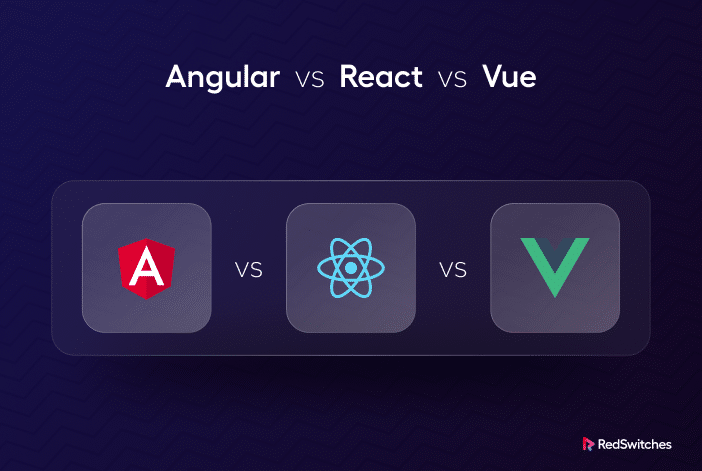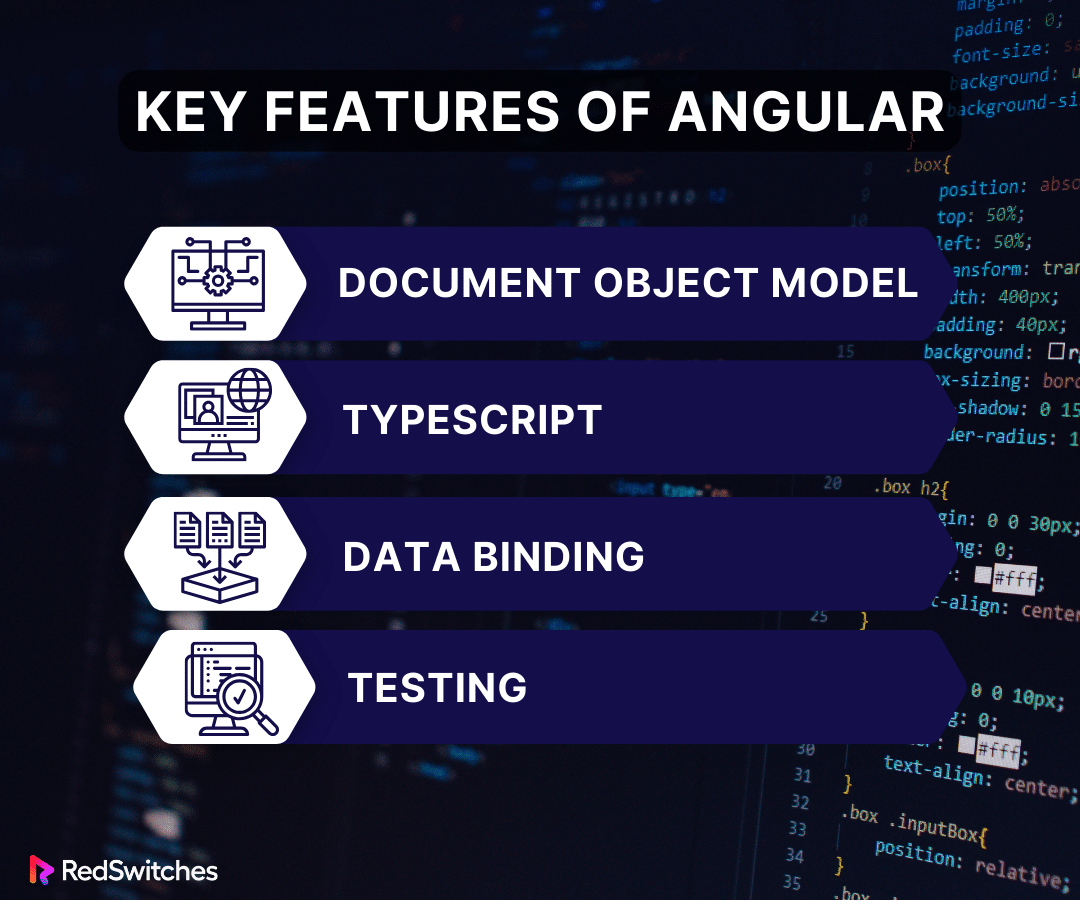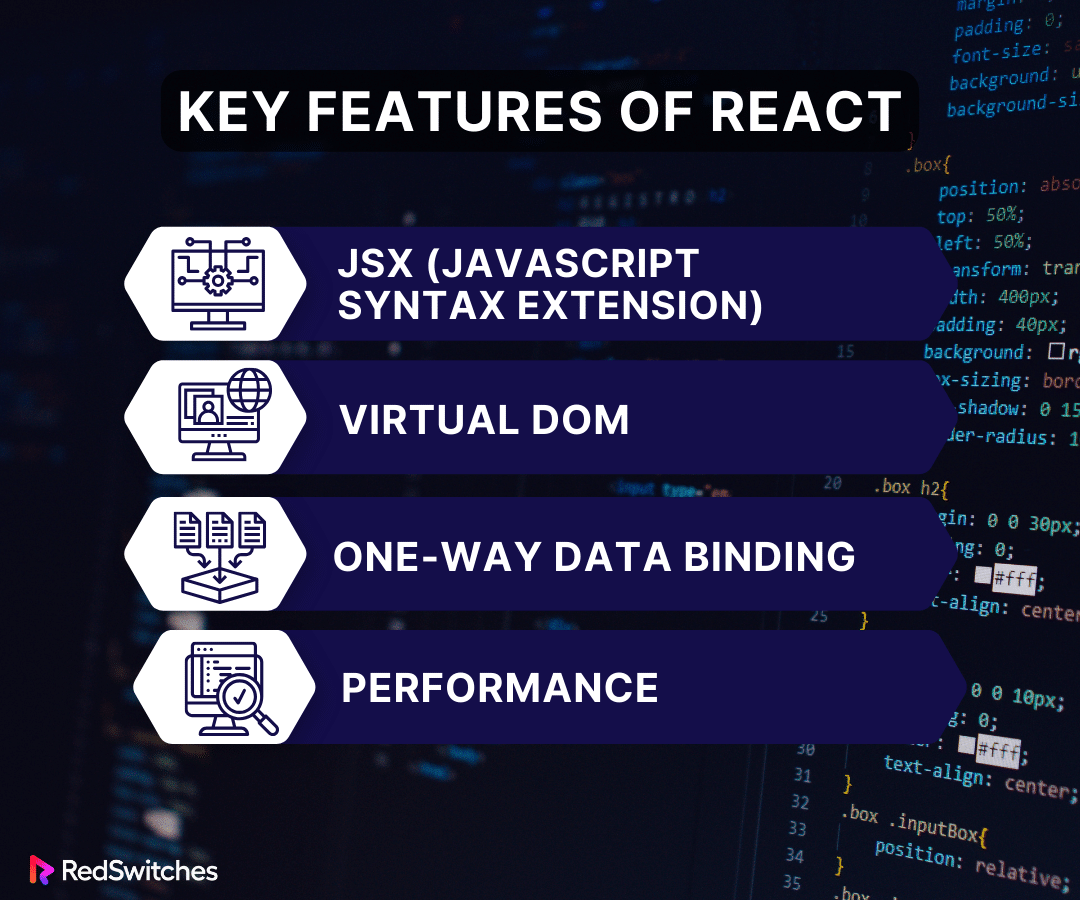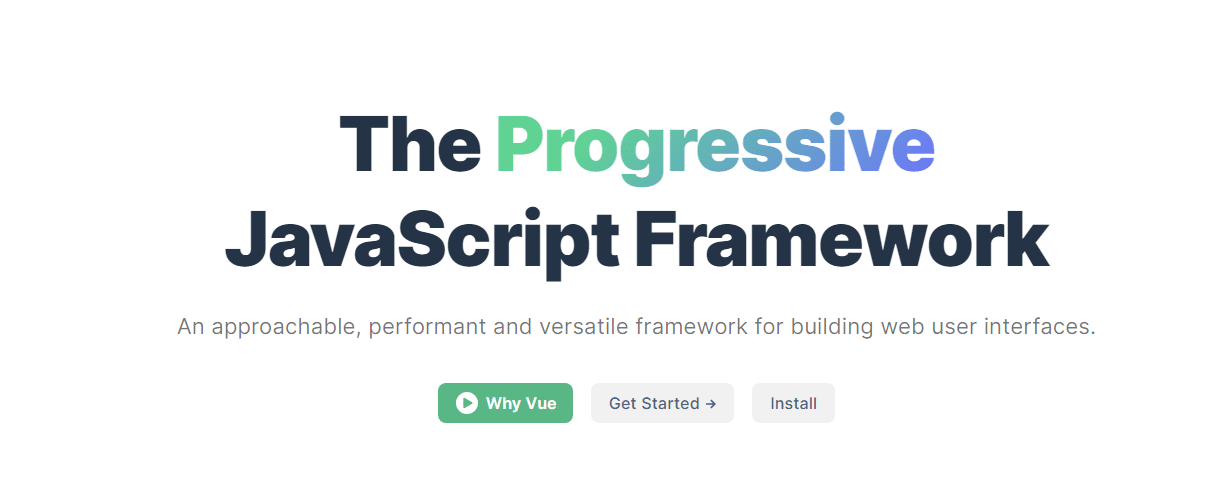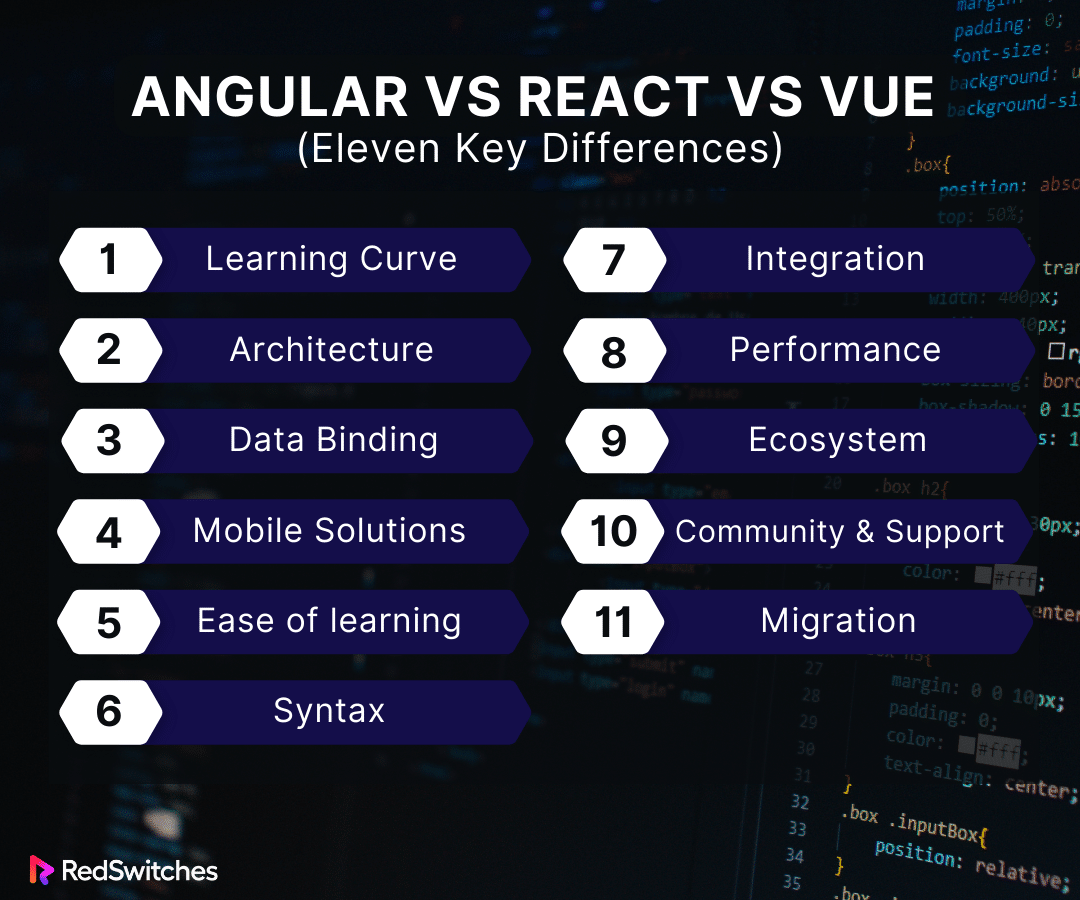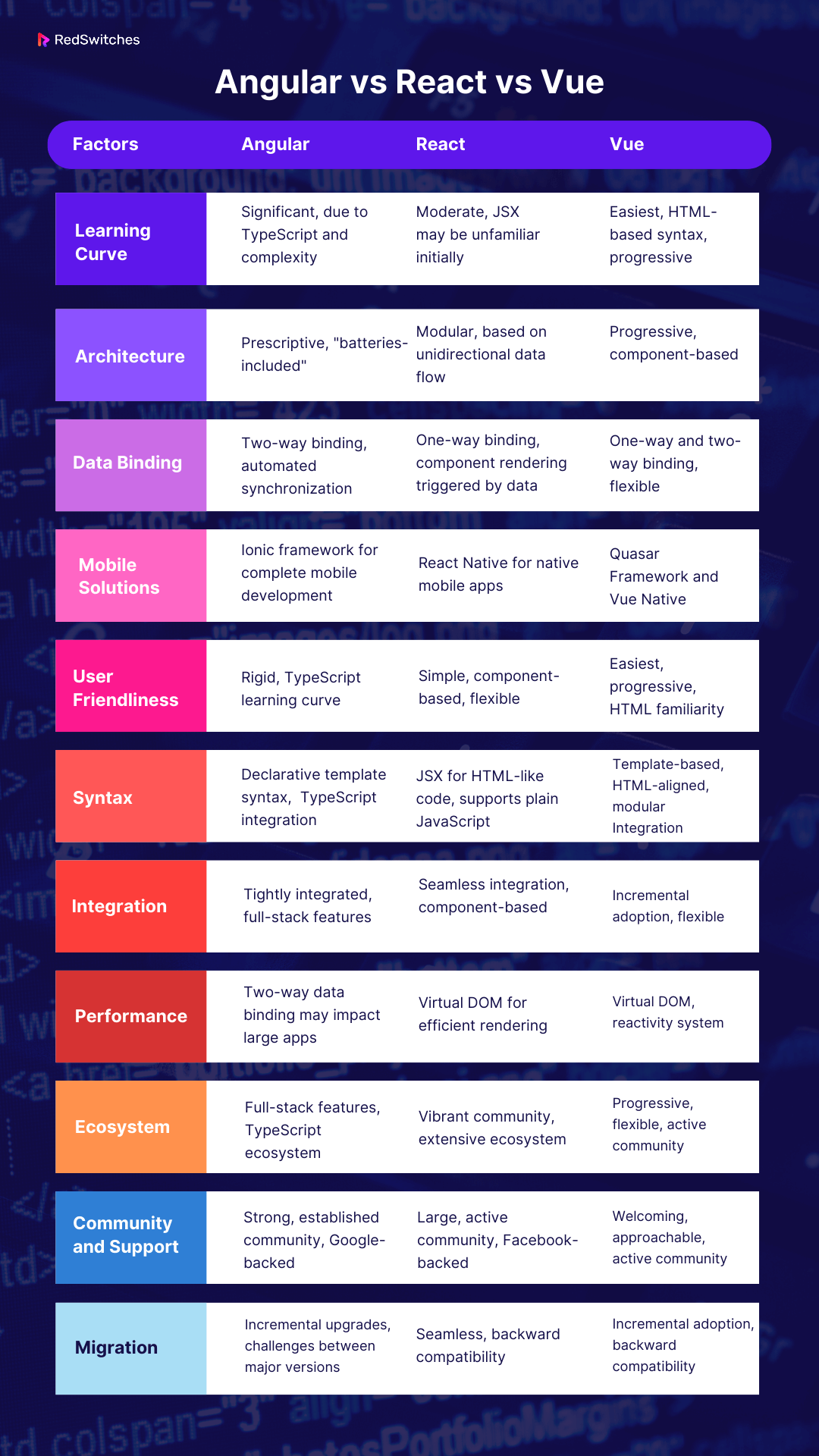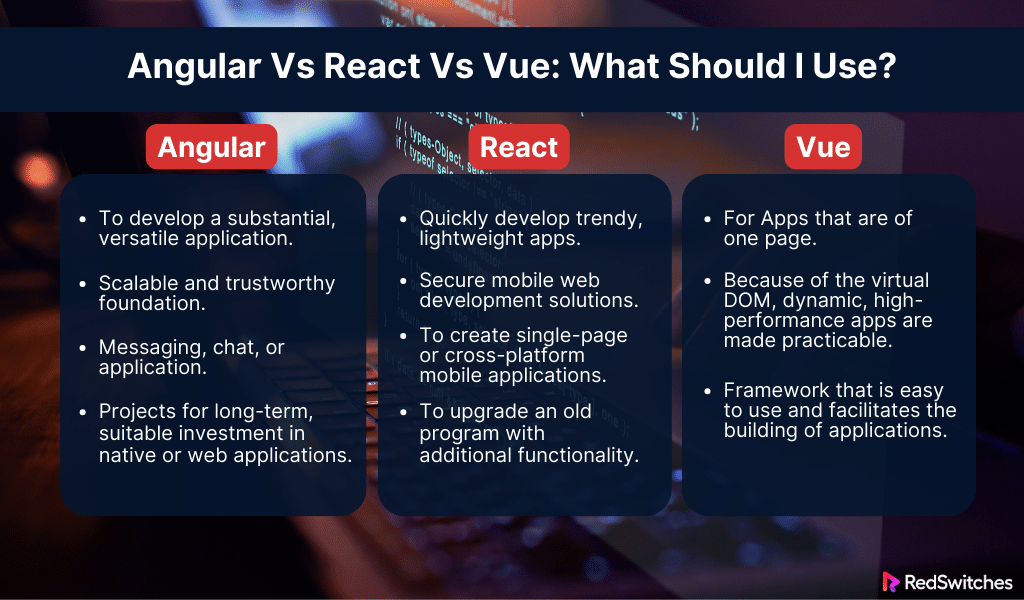Choosing the appropriate framework is crucial in the constantly changing world of web development. As clear frontrunners, Angular, React, and Vue.js have specialties and advantages.
In this enlightening blog post, we examine the core components of these technologies and break them down into 11 essential distinctions that every developer needs to be aware of.
Whether you’re a seasoned coder or a beginning enthusiast, knowing their differences is essential for making an educated choice. Join us on this investigation as we clarify the complexity, assisting you in deciding between Angular, React, and Vue and selecting the best framework for your upcoming ground-breaking project.
This blog article will explore the angular vs react vs vue debate.
Table of Contents
- What is Angular?
- What is React?
- What is Vue?
- Angular vs React vs Vue: Eleven Key Differences
- Angular vs React vs Vue: Learning Curve
- Angular vs React vs Vue: Architecture
- Angular vs React vs Vue: Data Binding
- Angular vs React vs Vue: Mobile Solutions
- Angular vs React vs Vue: User Friendliness
- Angular vs React vs Vue: Syntax
- Angular vs React vs Vue: Integration
- Angular vs React vs Vue: Performance
- Angular vs React vs Vue: Ecosystem
- Angular vs React vs Vue: Community and Support
- Angular vs React vs Vue: Migration
- Angular vs React vs Vue: Use Cases and Real-Life Examples
- Angular Vs React Vs Vue: What Should I Use?
- Wrapping Up
- FAQs
What is Angular?
Credits: Freepik
Angular is a JavaScript framework that is multiplatform and developed in TypeScript. Google maintains it, and its main use is to create single-page applications. Angular is a framework with great advantages that also gives programmers a constant framework to work with. It provides users the ability to make considerable apps in a manageable way.
With Angular, you can benefit from a platform that supports projects with a single developer to enterprise-level apps. You can also take advantage of the most recent advancements with the least effort because Angular makes updating as simple as possible. The best part is that the Angular ecosystem comprises a vast community of more than 1.7 million developers, library authors, and content producers.
Also read Three Simple Ways You Can Install Node.js On Ubuntu 22.04
Key Features of Angular
Before jumping on our core topic of the vue vs react vs angular argument, first, discuss the key features of Angular.
Document Object Model
The document object model (DOM) makes an XML or HTML page a tree-like structure, with each node indicating a different section of the content.
Regular DOM is used by Angular. Take into account that the identical HTML page has received ten revisions. Angular will update the full tree structure of HTML tags rather than just the previously modified ones.
TypeScript
Users can write more understandable JavaScript code by using TypeScript, which denotes a set of types for JavaScript. Thanks to JavaScript compilation, any platform can easily support the smooth operation of the TypeScript code.
Data binding
Data binding is a technique that lets consumers control web page elements in their web browsers. It uses dynamic HTML and doesn’t call for sophisticated scripting or programming. Web pages with interactive elements like calculators, tutorials, forums, and games require data binding. Data binding also allows web pages with a lot of data to be displayed more effectively incrementally.
Testing
Angular uses the Jasmine testing framework, which has numerous functionalities to create test case types. The test task-runner, Karma, configures the start-up, reporters, and testing framework in a configuration file.
Pros and Cons of Angular
Credits: Freepik
Now, let’s discuss the Benefits and Cons of Angular:
Pros
Architecture in Modules
The modular design of Angular makes it easier to organize code into digestible chunks, which encourages maintainability and reusability. By segmenting functionality, developers can improve the scalability of their programs.
Data Binding in Two Ways
The two-way data binding feature of Angular ensures that the model and the view synchronize flawlessly. This enhances real-time interactivity and streamlines development, as modifications made to the user interface immediately affect the program logic and vice versa.
Dependency Injection System
The dependency injection system that is integrated into Angular encourages the writing of testable, modular, and loosely coupled code. This method streamlines the component and service management process, which increases development efficiency.
Entire Ecosystem
Angular offers a complete suite of integrated tools and libraries, including RxJS, Jasmine, Protractor, and Angular CLI. This all-in-one framework ensures a unified and effective development experience by providing developers with tools for testing, project scaffolding, and reactive programming.
Cons
Slope of Learning
Directives, modules, decorators, components, services, dependency injection, pipes, and templates are some of the fundamental parts of Angular that every user should be familiar with. Change detection, zones, Ahead Of Time compilation, and Rx.js are more complex topics. Because it is a full framework, learning Angular 4 may be difficult for beginners.
Fewer SEO Alternatives
Angular has few SEO choices and is difficult for search engine crawlers to reach.
Migration
The challenge of converting existing JS/jQuery-based code to Angular-style architecture is one reason businesses do not regularly utilize Angular. Upgrading to each new release can also be challenging, and some are not backward-compatible.
What is React?
Credits: Pexels
React.js is a highly detailed open-source JavaScript package created by Facebook to streamline the complex process of creating dynamic user interfaces. Imagine a user interface created with React as a set of components, each in charge of producing a brief, reusable HTML code.
You design your applications with React by building reusable components—which you may conceive as separate Lego blocks. These elements are discrete parts of a final interface that, when put together, make up the full user interface for the application.
Key Features of React
JSX (JavaScript Syntax Extension)
JSX combines JavaScript and HTML. HTML elements can contain JavaScript objects implanted inside of them. Because web browsers do not support JSX, the code is converted into JavaScript along the compiler called Babel. Codes are made easy and clear via JSX. If you know HTML and JavaScript, learning this is simple.
Virtual DOM
DOM, or Document Object Model, is a technical term. Because it differentiates into modules and runs the code, it is the most important component of the web. The DOM is usually updated by JavaScript Frameworks, which slows down the web application. However, React employs virtual DOM, a perfect replica of real DOM.
One-way Data Binding
As the name implies, one-way data binding is a one-directional flow. React only permits data to flow in one direction, from top to bottom, or from parent components to child components.
The child component’s properties (props) can communicate with the parent components to change the states based on the inputs provided, but they cannot return data to the parent component. One-way data binding operates in the manner described above. Everything remains fast and modular as a result.
Performance
As we just established, react updates only the updated portions of the DOM using virtual DOM. In turn, this speeds up the DOM. DOM runs in memory, allowing us to isolate components and speed up DOM execution.
Pros and Cons of React
Credits: Freepik
Let us enlighten you on the benefits and cons of React.
Pros
Architecture based on components
Vanilla JavaScript-based apps frequently reach a point when controlling the state of data in the user’s browser causes developers problems. Maintaining an application using vanilla JavaScript becomes more challenging as the data and complexity increase.
Superior Performance
React’s component-based architecture makes it possible to build highly scalable single-page applications (SPAs) in which content is loaded dynamically rather than the entire page when users interact with the application.
But this can be a trap. Imagine being required to update the DOM for each change brought about by user interaction with a web page.
Redux
Redux is a dependable state management toolkit that works well with React in JavaScript applications. It makes managing and debugging the application easier by preserving its state in a centralized repository.
Redux improves the predictability and scalability of React apps by mandating a unidirectional data flow and offering a defined structure for state changes through actions and reducers. With features like time-travel debugging, this centralized method makes the state more accessible, encourages code maintainability, and makes debugging more efficient.
Simple to Learn
Another benefit of using React is that it can be learned by any developer familiar with HTML and JavaScript. Unlike other JS frameworks like Angular, which establishes many new terms, React makes the most of what is currently out there. It is also quite simple to use, so it has become the most widely used JS library.
Cons
High Developmental Speed
Perhaps the biggest criticism of utilizing React is this. React developers are required to alter the way they write code because the library is not just expanding quickly but also evolving quickly.
This is infuriating for most developers who do not feel comfortable trying new things every Monday when they begin their work or for those working on applications where updates are essential for users.
Lack of conventions and flexibility
You did read that correctly. Although I am aware that it was mentioned as a benefit of utilizing React, it is also a drawback in a more general sense. There are universal rules for how developers should interact with libraries, languages, or frameworks and the styles or patterns they should use.
With React development teams, it is difficult to predict what standards or styles they may adhere to, making it more difficult for new developers to work with them and their standards. Knowing this can be useful, because when developers change teams, they know what patterns or styles the new team may be following.
Not an all-inclusive framework
Developers do not like what they can have in a fully equipped framework like Angular (another well-liked JS Framework), even if React is a powerful JavaScript library with interactive and practical features necessary for building large-scale applications.
React solely manages the view portion of the MVC (Model View Controller) architecture.
Additional libraries and tools are required for the Controller and Model. This may lead to a lackluster pattern and organization in the code. While frameworks like Angular offer the full MVC feature set on a better-organized, well-managed foundation.
Also read Yarn Installation On Linux and Windows: A Comprehensive Guide
What is Vue?
Credits: VUEJS
A JavaScript framework called Vue.js is used to create single-page applications (SPAs) and user interfaces (UIs). Vue.js is free and open-source, just like the best of them. Model-view-view-model (MVVM) is the architectural design pattern used.
The framework, created by Evan You and launched in 2014, directly results from You’s experience with AngularJS while working at Google. You desired to design a completely new framework that was noticeably lightweight while still retaining the elements of AngularJS that he liked.
Key Features of Vue
Before moving on to the angular vs react vs vue debate, Let’s briefly discuss some of Vue’s critical features.
Virtual DOM
The term “virtual DOM” denotes a digital counterpart of the Document Object Model (DOM). It serves as a tool to construct a JavaScript object mirroring the authentic DOM. Whenever a modification to the DOM is required, a new JavaScript object is generated, and the alteration is implemented on this representation.
Subsequently, the final updates are determined and applied to the real DOM by comparing the original and modified JavaScript objects. This approach enhances efficiency and facilitates seamless manipulation of the DOM without directly interacting with the browser’s main document structure.
Data Binding
VueJS employs a data binding mechanism facilitated by the v-bind directive. This directive connects data in the Vue instance and HTML elements. With v-bind, developers can dynamically manipulate or assign values to HTML properties, alter styles, and apply classes.
This data binding functionality enhances the flexibility and responsiveness of VueJS applications, allowing for seamless synchronization between the underlying data in the Vue instance and the presentation in the HTML markup.
Components
VueJS introduces a pivotal concept known as components, independent elements possessing their own encapsulated data logic and view. This modular approach allows developers to construct distinct elements with self-contained functionality and presentation.
Components serve as a noteworthy feature in VueJS, enabling the creation of reusable and modular building blocks that can be seamlessly integrated across different parts of an HTML structure. This enhances code organization and maintainability and promotes the efficient development of scalable and flexible VueJS applications.
Event Management
In VueJS, DOM elements incorporate a property known as v-on, enabling them to listen to events actively. This capability facilitates handling user interactions or system events within VueJS applications. Furthermore, VueJS offers various methods for implementing transitions when HTML elements undergo addition, update, or removal from the DOM.
To achieve transition effects, the element undergoing the transition must be enveloped within VueJS’s built-in transition component. This component acts as a wrapper, facilitating smooth and visually appealing transitions between different states of the DOM element. VueJS’s transition system provides a straightforward and declarative approach to incorporating animations.
Moreover, VueJS supports integrating third-party animation libraries, offering developers the flexibility to enhance the interface’s interactivity. This extensibility ensures that VueJS applications can easily leverage additional animation capabilities, contributing to a more dynamic and engaging user experience.
Pros and Cons of Vue
Before heading toward our core topic, i.e., Angular vs React vs Vue debate, let’s learn about the pros and cons of Vue.
Pros
Small size
This point is as insignificant as Vue itself: The framework’s downloadable zip file is 18 KB. Being lightweight, it installs quickly and improves your SEO and UX.
Performance and rendering of virtual DOM
When rendering web pages, you’ll undoubtedly encounter a Document Object Model (DOM). A DOM depicts an HTML page as a tree structure of objects (nodes) with their styles, elements, and content. A browser creates and stores the DOM tree objects when a page is loaded.
Options for data binding and reactivity
Data binding links the view’s DOM or HTML template to the data model (data source). Thanks to one-way data binding, information can only move in one direction, from model to display or vice versa. In the first situation, changes to the source update the DOM automatically. Still, the opposite is impossible since the DOM has read-only access to the model.
Cons
Limited Ecosystem
While Vue’s small size is advantageous, it also translates to a smaller ecosystem than larger frameworks like React or Angular. This can sometimes result in fewer third-party libraries, tools, and community support, potentially limiting the available resources for developers.
Learning Curve for Large-Scale Applications
While Vue is known for its simplicity, the learning curve may increase when dealing with large-scale applications. As the project complexity grows, developers may find it challenging to maintain a clean and scalable code structure, leading to potential issues in project management and collaboration.
Less Corporate Backing
Unlike React (supported by Facebook) and Angular (backed by Google), Vue lacks a major corporate sponsor. While Vue’s open-source nature promotes community-driven development, the absence of strong corporate backing may impact its long-term viability and adoption in enterprise-level projects.
Also Read Web Application Security 101: What It Is, How It Works, Best Practices, & More
Angular vs React vs Vue: Eleven Key Differences
Credits: Freepik
We will discuss the core section of our blog, Angular vs React vs Vue: 11 critical differences in detail. Let’s begin.
Angular vs React vs Vue: Learning Curve
Angular
Because of its dependency on TypeScript, Angular has a significant learning curve. Developers who are used to dynamically typed languages may find it challenging to learn TypeScript as well as the concepts and architecture of Angular.
Due to its complexity, which includes features like dependency injection, decorators, services, and modules, the framework has a longer learning curve. Although Angular offers thorough and well-structured documentation, newcomers may initially be overwhelmed by its sheer amount.
React
React uses JSX, a syntactic extension, and JavaScript for component construction. Although JSX may not look recognizable at first, it’s quite simple to understand, especially for developers familiar with HTML.
React’s component-based architecture makes learning easier by letting developers start with basic components and work up to more sophisticated ones.
Vue
Vue sets itself apart with a syntax based on HTML, which makes it accessible to developers who are familiar with HTML. Because of Vue’s progressive framework, developers may gradually integrate more Vue features into their projects by starting with smaller ones. Vue is frequently complimented for its simplicity, and its lucid and succinct documentation makes learning about it easier.
This demonstrates that Vue has a much easier learning curve than React and Angular.
Angular vs React vs Vue: Architecture
Angular
Angular employs a thorough, prescriptive architecture that is frequently known as a “batteries-included” strategy. Modules, decorators, services, and components form the foundation of the architecture.
Components are the fundamental units of an Angular application. They contain the HTML templates, styling, and behavior. Modules arrange the application into coherent units, whereas services manage the program’s data and logic.
React
The architecture of React is based on a more adaptable and modular methodology. It is based on a unidirectional data flow in which changes in data trigger component rendering. Reusable components that manage their state and lifecycle routines are used to construct React applications. Through selective updates to the modified portions of the original DOM, the Virtual DOM optimizes rendering.
Vue
Vue’s architecture is progressive and adaptable gradually. Fundamentally, Vue apps are made of React-like components. Every element encompasses its style, behavior, and template. Vue uses reactive data-binding, which enables automatic view updates when underlying data changes.
Angular vs React vs Vue: Data Binding
Angular
Angular uses a two-way data binding technique to provide automated synchronization between the model and the view. This implies that modifications made to the model instantly affect the view and vice versa.
Angular accomplishes this via event binding (from component view) and property binding (from component to view). While in some circumstances, this simplifies development, in larger applications, it could result in performance problems.
React
React employs a unidirectional data flow in which changes in data trigger component rendering. React mainly uses one-way data binding, which flows from parent to child components. Using properties (props) to send data down the component tree facilitates this unidirectional approach.
Vue
Vue supports one-way and two-way data binding, giving developers flexibility. Like React, props are used to accomplish one-way data binding for parent-to-child communication.
Vue offers the v-model directive for two-way binding, simplifying the binding process from input components to data. Vue’s reactivity system allows the display to adjust automatically when the underlying data changes.
Angular vs React vs Vue: Mobile Solutions
Angular
With Ionic, Angular offers a complete mobile development solution. Ionic is a framework that runs on top of Angular and uses its elements and functionalities. It makes it possible to create cross-platform mobile apps with web technologies like TypeScript, HTML, and CSS.
With the pre-built UI components that Ionic provides, creating a unified and responsive mobile user experience is much simpler. Building scalable mobile applications is made easier by Angular’s modular architecture and robust dependency injection technology.
React
React provides several choices for developing mobile applications, the two main ones being React for the Web and React Native. With React Native, developers can use JavaScript and React to create native mobile applications. It allows for code sharing between several platforms, including Android and iOS, resulting in performance that is almost native.
Vue
Vue offers an adaptable mobile development solution through the Quasar Framework and Vue Native. React Native and Vue Native are comparable; however, Vue.js-specific. It enables programmers to use Vue components to create native mobile applications. Although it is not just for mobile development, the Quasar Framework facilitates building responsive and readily packed applications for mobile devices.
Angular vs React vs Vue: User Friendliness
Angular
Angular, renowned for its rigid architecture, is less user-friendly for beginners because of TypeScript’s learning curve and the mandatory coding standards.
At first, the intricacy of Angular, encompassing ideas like modules and dependency injection, may be debilitating. Although the vast and well-organized documentation of the framework facilitates learning, beginners may find the sheer volume intimidating.
React
React is frequently commended for its simplicity and adaptability. Its component-based architecture and unidirectional data flow make it easy to grasp, and the lack of a rigid framework lets developers select the tools that best suit their needs.
The vibrant React community enhances the development experience by offering a wealth of tools and assistance with problem-solving.
Vue
Out of the three frameworks, Vue is the easiest to use. Its syntax is well-known because it is based on HTML and JavaScript, and its progressive architecture facilitates gradual adoption. Vue’s smooth learning curve, excellent documentation, and ease of use appeal to both novice and seasoned developers.
The official tutorials for the framework are incredibly user-friendly for beginners, which makes the onboarding process go more smoothly.
Angular vs React vs Vue: Syntax
Angular
Angular employs a declarative template syntax that combines directives unique to Angular with HTML. This syntax enables the development of dynamic views by integrating expressions, two-way data binding, and structural directives straight into the HTML templates.
TypeScript is a statically typed superset of JavaScript commonly used to write Angular apps. A more structured grammar, together with features like interfaces, decorators, and static typing, is introduced by TypeScript.
React
React introduces JSX (JavaScript XML), a syntax extension for JavaScript. With JSX, developers can write HTML-like code inside JavaScript files, making it easier to compose React components. Next, JSX is transpiled into JavaScript with programs like Babel.
Using a particular JavaScript flavor is not mandatory for developers using React. Although JSX is widely used, developers can also use simple JavaScript to create React components.
Vue
Vue’s syntax is template-based and closely aligned with HTML. Because it is based on HTML, this syntax is familiar and approachable for developers who are accustomed to it. Directives included in Vue templates bind data and manage the application’s flow.
Vue additionally facilitates the usage of single-file components, consisting of a component’s template, script, and styles in a single file. This modular strategy improves the readability and organization.
Angular vs React vs Vue: Integration
Angular
With built-in dependency injection, routing, and state management features, Angular offers a tightly integrated development experience. It is a complete and opinionated framework. Although full-stack apps may benefit from this cohesiveness, integrating Angular into projects that require a more flexible or lightweight approach may provide difficulties.
One of Angular’s main features, TypeScript integration, can be a benefit or a drawback, particularly for applications primarily using JavaScript.
React
Thanks to its component-based architecture, React excels at seamless integration into pre-existing applications. Developers can progressively add React components to particular project sections without requiring a total overhaul.
React’s wide ecosystem further improves integration capabilities, enabling smoother cooperation with different frameworks and tools.
Its reputation for flexible integration is partly due to its support for other libraries and its compatibility with state management solutions like Redux.
Vue
Vue is unique in that it is simple to integrate into already-existing projects because it is made for incremental adoption. Without committing completely, developers can use Vue for particular areas of an application and then progressively incorporate more components.
The versatility of Vue also extends to integration, as it allows developers to select the ideal tools and frameworks for particular jobs.
Angular vs React vs Vue: Performance
Angular
Because the model and the view must constantly synchronize, Angular’s use of two-way data binding might potentially add overhead in large systems, even while it increases development efficiency. The Angular change detection approach by default may result in many checks, which could affect performance.
On the other hand, developers can use techniques like OnPush change detection to maximize performance.
React
React’s virtual DOM implementation, which minimizes changes to the actual DOM and improves efficiency by allowing selective display of only the modified portions, is a noteworthy factor in its performance. React’s one-way data flow makes change tracking easier, which improves rendering process predictability and optimization.
Vue
Like React, Vue uses a virtual DOM to minimize changes made to the real DOM, which improves responsiveness. When underlying data changes, Vue’s reactivity system and virtual DOM work together to automatically identify the minimum number of components that need to be re-rendered, allowing for efficient updates.
Angular vs React vs Vue: Ecosystem
Angular
As a full-stack framework, Angular offers a feature-rich environment with a templating engine, dependency injection, and a strong CLI.
It comes with routing solutions, official libraries like NgRx for state management, and comprehensive tools and documentation. Because of Angular’s close relationship with TypeScript, developers may use the TypeScript ecosystem, which provides sophisticated tooling and static typing.
React
The size and vibrancy of the React community define the React ecosystem. Thanks to third-party libraries and tools, React developers have several alternatives for state management, routing, and UI component libraries.
React’s ecosystem gains further depth with React Native’s foray into mobile programming. The availability of React Developer Tools improves the debugging capabilities of React apps.
Vue
Vue emphasizes adaptability and flexibility and offers an ecosystem that supports its gradual adoption. Vue provides tools such as Vue CLI for project scaffolding, Vue Router for routing, and Vuex for state management. An ecosystem component called Vue Press generates static sites using Vue elements; it’s very helpful for blogs and manuals.
Though not as large as React, Vue nevertheless has a vibrant community, and numerous contributions from outside developers enhance the ecosystem.
Angular vs React vs Vue: Community and Support
Angular
Angular have a strong, established community that Google supports. The framework has been used for some time and has a sizable user base. Developers have access to many resources thanks to the comprehensive documentation, official guides, and tutorials. For newcomers, though, the sheer amount of documentation might be daunting.
The community shares expertise and offers support through actively participating in forums, discussion groups, and events.
React
React boasts one of the biggest and busiest followings within the front-end development community. Facebook developed and maintains React, which benefits from constant updates and broad adoption. The React community has produced various third-party libraries and tools by actively contributing to the ecosystem.
React Developer Tools, a plethora of online resources, tutorials, and community forums, strongly support developers of all skill levels.
Vue
Despite having a smaller community than Angular and React, Vue is renowned for having a welcoming and approachable vibe. The community actively participates through social media, forums, and Vue-specific events. Evan You, the man behind Vue, is involved in the community and promotes teamwork.
Clear and succinct documentation facilitates A smooth learning curve and the ecosystem gains from numerous third-party contributions.
Angular vs React vs Vue: Migration
Angular
Because Angular has undergone significant modifications from AngularJS to Angular (2+), migrations are difficult due to architectural and conceptual differences between the two versions. A significant rewrite is often involved in the migration process. Angular offers incremental upgrades within the framework for more seamless transitions between minor versions.
React
Thanks to React’s exceptional incremental adoption capabilities, developers may seamlessly incorporate React components into ongoing projects without starting from scratch. Because of its dedication to backward compatibility, version changes are made as smoothly as possible, causing the least interruption and providing flexibility for a gradual migration.
Vue
Vue and React both place a strong emphasis on backward compatibility and gradual adoption. Developers can gradually add Vue components, allowing for a more seamless migration process without requiring significant rewrites.
Vue is a practical alternative for projects thinking about migrating because of its incremental adoption strategy, backward compatibility, version-specific conversion guides, official migration assistance, and community support. Vue offers the materials and tools required for a seamless and managed migration process, regardless of whether you’re moving from Vue 2 to Vue 3 or integrating Vue into an already-existing project.
Let us summarize the Angular vs React vs Vue points in a tabular format.
| Learning Curve | Significant, due to TypeScript and complexity | Moderate, JSX may be unfamiliar initially | Easiest, HTML-based syntax, progressive |
| Architecture | Prescriptive, “batteries-included” | Modular, based on unidirectional data flow | Progressive, component-based |
| Data Binding | Two-way binding, automated synchronization | One-way binding, component rendering triggered by data | One-way and two-way binding, flexible |
| Mobile Solutions | Ionic framework for complete mobile development | React Native for native mobile apps | Quasar Framework and Vue Native |
| User Friendliness | Rigid, TypeScript learning curve | Simple, component-based, flexible | Easiest, progressive, HTML familiarity |
| Syntax | Declarative template syntax, , TypeScript integration | JSX for HTML-like code, supports plain JavaScript | Template-based, HTML-aligned, modular
Integration |
| Integration | Tightly integrated, full-stack features | Seamless integration, component-based | Incremental adoption, flexible |
| Performance | Two-way data binding may impact large apps | Virtual DOM for efficient rendering | Virtual DOM, reactivity system |
| Ecosystem | Full-stack features, TypeScript ecosystem | Vibrant community, extensive ecosystem | Progressive, flexible, active community |
| Community and Support | Strong, established community, Google-backed | Large, active community, Facebook-backed | Welcoming, approachable, active community |
| Migration | Incremental upgrades, challenges between major versions | Seamless, backward compatibility | Incremental adoption, backward compatibility |
Angular vs React vs Vue: Use Cases and Real-Life Examples
Credits: Freepik
After indulging in detail regarding the react vs vue vs angular debate, in this section of our blog, we will deal with the real-life uses of each in brief.
Angular
Google created and maintains Angular, a robust framework perfect for creating complex, feature-rich apps. Enterprise applications, CRM platforms, and project management solutions are common use cases. Examples of real-world Angular apps include Microsoft Office, Forbes, and Google Cloud Platform.
React
Facebook created React, a flexible and popular toolkit for creating user interfaces. It works best with interactive interfaces and single-page applications. E-commerce platforms, social media applications, and interactive dashboards all favor React. Facebook, Instagram, and WhatsApp are a few platforms where React is used.
Vue
Vue is a modern framework that combines flexibility and simplicity. It’s ideal for creating simple user interfaces and applications. Vue is frequently used for small to medium-sized projects, including creative endeavors, personal websites, and online applications. Nintendo, Xiaomi, and Alibaba are a few notable examples.
Angular Vs React Vs Vue: What Should I Use?
After discussing Angular vs React vs Vue, we know that when creating a web application, Angular is a complete toolset that provides everything from development to testing. React is a flexible library that relies on the guidance of other libraries to grow. Vue.js is a tremendous framework for developing user interfaces and single-page apps with a slight learning curve. So, let’s discuss which cone to choose in the React vs Angular vs Vue debate.
Select Angular:
- To develop a substantial, versatile application.
- Scalable and trustworthy foundation.
- Messaging, chat, or application.
- Projects for long-term, suitable investment in native or web applications.
Select React if you’d like:
- Quickly develop trendy, lightweight apps.
- Secure mobile web development solutions.
- To create single-page or cross-platform mobile applications.
- To upgrade an old program with additional functionality.
Choosing Vue.js is optional.
- Apps that are one page.
- Because of the virtual DOM, dynamic, high-performance apps are made practicable.
- Framework that is easy to use and facilitates the building of applications.
Wrapping Up
This blog highlighted the critical differences in the Angular vs React vs Vue debate.
React does not have comprehensive, current documentation. Since it is open source, new libraries are added virtually daily. This is a significant benefit for seasoned developers, but it might be difficult for new developers to understand.
Angular simplifies finding the data you require. The product comes with thorough instructions and other directions. If you still have questions, you can ask community members on any well-known site.
There is some of the best documentation available for Vue.js. ReactJS greatly impacted the architecture, which was based on components. Vue is a modernized framework that offers adopted development possibilities, but its youth is evident in its lack of a community and other restrictions.
No matter the framework you select, having a dependable hosting service is essential to ensuring top performance and a positive user experience. RedSwitches can be very helpful in this situation. Developers may concentrate on creating outstanding online apps with our first-rate hosting services rather than worrying about server scalability, security, or reliability difficulties.
FAQs
Q. Which is better: Angular vs React vs Vue?
The demands of your project will determine the best course of action. React for adaptability, Vue for ease of use, and Angular for intricate, extensive projects.
Q. How much quicker is Angular than Vue?
Although Angular and Vue’s performance is comparable, it greatly depends on optimization and the particular use case.
Q. Why should I use Vue instead of React or Angular?
Vue is chosen because of its simplicity, simplicity of integration, and reduced learning curve, making it perfect for smaller projects and front-end framework newcomers.
Q. What is the difference between Angular, React, and Vue.js?
Angular, React, and Vue.js are popular JavaScript frameworks for building user interfaces and single-page applications. Developed by Google, Angular is a full-fledged front-end framework, while React is a JavaScript library for building user interfaces, and Vue.js is a progressive framework for building user interfaces.
Q. Which companies are using React?
Companies like Facebook, Instagram, Airbnb, and Netflix use React to build web applications.
Q. What are the major advantages of using Angular?
Angular has strong Google backing, provides a robust structure for building large-scale applications, and offers enhanced features like two-way data binding and dependency injection.
Q. When should I use Vue.js over Angular?
Vue.js is a good choice for small to medium sized projects and for developers who prefer flexibility and ease of integration into existing projects.
Q. What are the key features of React?
React provides component-based architecture, virtual DOM for performance optimization, and the ability to use JSX for templating.
Q. What are the major differences between Angular 2 and Angular 8?
Angular 2 introduced a complete revamp of the framework, while Angular 8 focused on improved tooling and performance optimization.
Q. Which framework should I choose in 2023 for front-end development?
The choice of framework depends on the specific project requirements, team expertise, and community support. Evaluating the pros and cons of each framework for your project is crucial.
Q. How does Vue.js compare to React in terms of performance?
Vue.js and React are both known for their performance. Vue.js is lightweight and has a smaller bundle size, while React’s virtual DOM offers efficient updates.
Q. Is Angular suitable for developing web apps in 2024?
Angular continues to evolve and remains a popular choice for developing web applications with its features and robust support from Google.
Q. What is the primary debate of Angular vs React vs Vue.js?
The primary debate revolves around each framework’s unique features, performance, and suitability for different types of projects and developer preferences.
